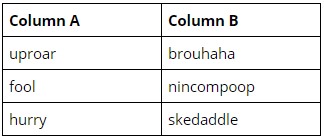Use Hyperbole (Blow Your Words Out of Proportion)
Episode #6 of the course Humor boosters: Lighten and tighten your writing by Gay Merrill
You’ve reached Lesson 6 (Woohoo!) So far, you’ve found your funny bone, started a humor journal, used super-specific words to paint a funnier picture, applied the joke structure, and now recognize this list of learned items doesn’t follow the rule of three.
Today’s lesson covers the art of using hyperbole, or how to “blow your words out of proportion”, in other words… exaggerate.
Caricature artists exaggerate physical appearance to highlight a person’s unique features. Comedians exaggerate speech and body language mannerisms to joke about human experiences. And writers exaggerate words to stretch the truth.
But to be funny, the exaggeration needs to be extreme. You need to create a mismatch between reality and the exaggerated image your words create. Stretch the truth to absurdity.
Dilbert cartoonist and humorous writer Scott Adam shares this advice on his blog about using exaggeration:
“Figure out what’s the worst that could happen with your topic, then multiply it by ten or more. Don’t say a mole is as big as a grapefruit. Say that mole is opening its own Starbucks… The bigger the exaggeration, the funnier it is.”
So to exaggerate, go BIG… or go teeny.
Let’s look at a few simple examples.
Note from these examples, the exaggeration comes from making a comparison or creating an absurd description. As you learned in Lesson 3, choosing super-specific words, such as Fido, kibble, Zelda, and Justin Bieber, also creates a funnier picture.
By itself, exaggeration doesn’t create humor. To get a laugh (a guffaw, a smirk, or eye roll), you need to create an absurd image for your audience. The humor comes from extreme comparison. You also want to make sure you add the punch to the end.
Now let’s look at how you can turn a small sample of writing into a funnier, exaggerated version.
How to Create an Exaggeration
Step 1. Look through your writing to find ideas you can emphasize with hyperbole. Do you mention objects, emotions, actions you can exaggerate?
Step 2. Choose one of your ideas to exaggerate.
Step 3. Come up with a list of rewrites.
Step 4. Choose the rewrite you like best. Tweak your words to get the right level of exaggeration.
Example
Here’s an example of applying the steps to a bit based on my old car.
1. I drove a 2006 SUV (for 13 years) that racked up over 250,000 kilometers, so I was often at my garage for repairs.
2. In my sentence, I can exaggerate the age and mileage of my car as well as the frequency I go to my garage.
3. Here are some rewrites:
I drive an SUV that has so many kilometers…
• My garage is on speed dial.
• I see my mechanic more often than my family.
• My car’s maintenance history has its own database.
4. I chose the last rewrite and tweaked it:
My SUV has so many kilometers, its maintenance history shuts down the Internet.
When you use exaggeration, stretch it as far as it can go to make it absurd. If you succeed, your readers will enjoy the humor.
Practice. Practice. Practice. The more you exaggerate, the easier it gets.
Exercise
1. Refer to the examples in the table above, and try giving these sentences a humor boost using exaggeration:
• The meal was bad.
• His (or her) hair is messy.
• The dog was happy.
• The road was slippery.
• I was late.
2. Go back to your writing sample you created for Lesson 2 (What? You didn’t complete the exercise in that lesson. Okay, now’s your chance to go back and do it.) Find a sentence or idea you can exaggerate and follow the steps in this lesson to create several rewrites. Choose the rewrite you like best.
Next lesson you’ll learn to twist a device poets often use (no rhymes are required).
Recommended book
How to Write Funny by Scott Dikkers
Share with friends


